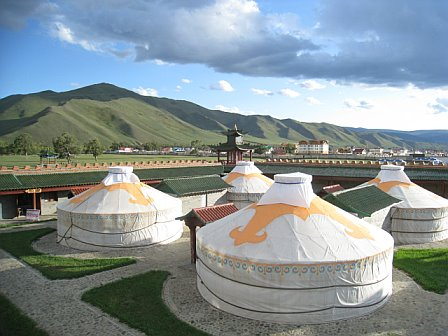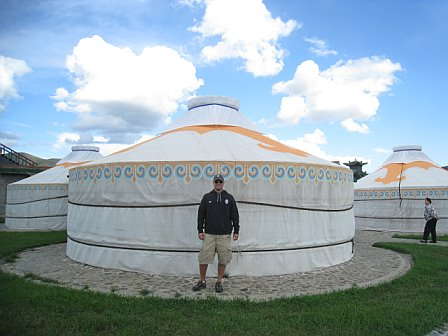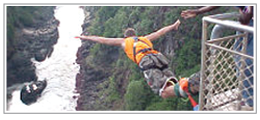
If you were to mix up dramatic landscapes of empty deserts, rolling green hills that look like putting greens running up a mountain, snow capped peaks and sparkling lakes-you would have the start of a place like Mongolia. Throw in a few felt yurts of the nomad people, Buddhist temples, ruins, great wildlife, warm hospitality and the cry of an eagle. Top it off with a timeless conqueror that started with nothing and ended up changing the course of history then you would have Mongolia. However, if Chinggis Khaan were to see the hordes of SUV’s plying down Peace Avenue along with Manhattan style cocktail bars, legions of cell phone users and eco yurts-he may just turn green with envy…or roll over in his grave-I’m not sure.
Regardless of how old Chinggis would feel, since the end of Communism, Mongolia has done everything in its power to be open with the world. It has managed to keep its identity and wildlife in tact but has reached out to the West for investment in its vast mineral wealth and the world has responded in huge numbers. Aside from a large amount of expats living and working in Mongolia, it is also not uncommon to meet people with degrees from elite US and British Universities. Education is a high priority for Mongolians and they are one of the most educated and literate people in Asia.
All is not perfect for Mongolia though. They still have one of the lowest average incomes per capita in Asia and the recent economic crisis has hurt their exports but on the bright side, their currency hasn’t been crushed too badly because they don’t tend to invest in foreign mortgage and asset backed securities like most western governments do. Additionally, foreign direct investment is sticking with Mongolia through this tough time because of their stable government and openness. However, the main reason most certainly is because of their enviable or unenviable geographic position of being wedged right in between the two giants of Asia, Russia and China.
I arrived in Ulaanbaatar (UB), the capital of Mongolia after a long and tumultuous journey from New York that included several hours of screaming babies, no in flight entertainment system on Air China and a 4 hour layover in Beijing so needless to say I was exhausted when I arrived at about midnight local time. However, I was taken aback by the hotel that I had booked online the day before on a whim after I heard it was a pit stop for the Amazing Race TV show.

Hotel Mongolia is a gorgeous place with several high end yurts that are actually heated and have bathrooms. I say heated because at night it gets below freezing even in the middle of August as I found out the hard way arriving wearing shorts and a tee shirt as usual. The grounds of the hotel are divine and very peaceful. The onsite restaurant has excellent food and breakfast is included along with nightly Mongolian themed shows including Mongolian style wrestling and also a fire show. The staff here is very friendly and honestly this is one of the coolest and best hotels I have been to. It’s unique style and out of the city location are awesome. I highly recommend staying here if you happen to be in UB.
Ulaanbaatar is at a crossroads of Asia and the people that I have met here are all on their way to somewhere else or coming back from somewhere else. It is a popular stop off from the Trans-Siberian railroad which goes from Moscow to Beijing via either Ulaanbaatar or to Vladivostok in the Russian Far East. Weary travelers are excited by the prospects of getting some real food after 5-10 days on the train from Moscow where the food is apparently awful and the cabins uncomfortable. I am fortunate to have met several here at the hotel that are chilling out for a few days and taking in some clean air and simply not being on the train. I say this kind of in jest because I will riding the world’s highest train for the next 2.5 days from Beijing to Lhasa, Tibet so let’s hope it’s better than what I’ve heard about the Trans-Siberian.
Ulaanbaatar city proper is a strange mix of Soviet architecture and Chinese traffic. That is a common theme here as many things are a mix of Russian and Chinese. The people for instance look Chinese but speak a Cyrillic language that sounds Russian. All signs are in Cyrillic which for me was nice as I can actually read Cyrillic whereas Chinese I am worthless at. The city itself has a nice main square called Sukhbaatar Square which is where the main government buildings are and the square actually resembles a small Tiananmen Square. The area around the square is where most of the cultural and high end sights and shops are. The streets are very peaceful albeit congested with traffic and again the people are super pleasant and very helpful.
The city is situated in a valley surrounded by rolling green hills and mountains and the best comparison I can make is to Bishkek, Kyrgyzstan which is also very similar in looks and surroundings. The views are spectacular in and around the city. The city itself is OK. It is nice but the sights are limited. You aren’t going to Mongolia to hang out in the city. You go to see the gorgeous scenery and wildlife surrounding it and running off from Siberia and up from China. The vastness and emptiness are astounding and will make even the most jaded traveler take notice.
My only regret with Mongolia is a common regret that I wish I had more time to travel more out into the country and take advantage of the budding new adventure tourism trips they are marketing here in Ulaanbaatar which entails rafting, hiking and speed-boating. However, I feel that I’ve had a great introduction to Mongolia here in my three days and I imagine it won’t be too long before this place really takes off as a destination for intrepid travelers as a destination in and of itself instead of just a stop off point between the two giant nations.












Nice picture, looks awesome
Beautiful picture
Where’s the beef?